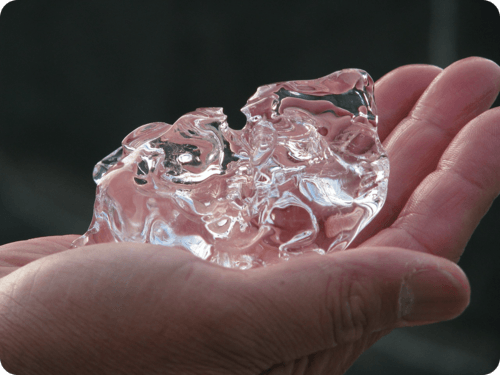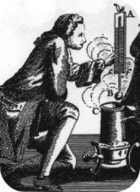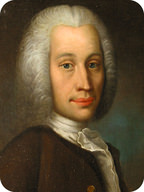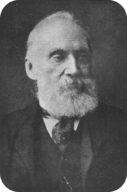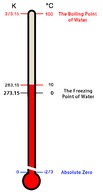温度和温度缩放
章节大纲
-
An ice cube in your hand feels cold, but why?
::你手里的冰块冰冷,但为什么?The particles of matter in a hot object are moving much faster than the particles of matter in a cold object. An object’s is the energy due to motion. The particles of matter that make up the hot stove have a greater amount of kinetic energy than those in the ice cube.
::热天体中的物质粒子的移动速度远快于冷天体中的物质粒子的移动速度。 一个物体的能量来自运动。 构成热火炉的物质粒子的动能大于冰块中的动能。Temperature and Temperature Scales
::温度和温度缩放Temperature is a measure of the average kinetic energy of the particles in matter. In everyday usage, temperature indicates a measure of how hot or cold an object is. Temperature is an important parameter in chemistry . When a substance changes from solid to , it is because there was an increase in the temperature of the material. usually proceed faster if the temperature is increased. Many unstable materials (such as enzymes) will be viable longer at lower temperatures.
::温度是测量物质中颗粒的平均动能的尺度。 在日常使用中, 温度表示一个物体的温度或寒冷程度。 温度是化学中的一个重要参数。 当物质从固体向...变化时, 是因为物质温度上升了。 如果温度升高, 通常会更快地进行。 许多不稳定物质( 如酶)在较低的温度下会更长的寿命 。The glowing charcoal on the left represents high kinetic energy, while the snow and ice on the right are of much lower kinetic energy.
::左边的发光木炭代表着高动能,而右边的雪和冰的动能则低得多。Temperature Scales
::温度缩度The first thermometers were glass and contained , which expanded and contracted as the temperature changed. The German scientist, Daniel Gabriel Fahrenheit used mercury in the tube, an idea put forth by Ismael Boulliau. The Fahrenheit scale was first developed in 1724 and tinkered with for some time after that. The main problem with this scale is the arbitrary definitions of temperature. The point of water was defined as 32°F and the boiling point as 212°F. The Fahrenheit scale is typically not used for scientific purposes.
::第一个温度计是玻璃,里面的温度计随着温度的变化而扩大和缩小。德国科学家Daniel Gabriel Fahrenheit在气管中使用了汞,这是Ismael Boulliau提出的一个想法。Fahrenheit 比例尺最初于1724年开发,并在该比例尺之后经过一段时间的修补。这个比例尺的主要问题是温度的任意定义。水点被定义为32°F,沸点被定义为212°F。Fahrenheit 比例尺通常不用于科学目的。Daniel Gabriel Fahrenheit.
::丹尼尔·加布里埃尔·法赫伦(Daniel Gabriel Fahrenheit)The Celsius scale of the metric system is named after Swedish astronomer Anders Celsius (1701-1744). The Celsius scale sets the freezing point and boiling point of water at 0°C and 100°C respectively. The distance between those two points is divided into 100 equal intervals, each of which is one degree. Another term sometimes used for the Celsius scale is “centigrade” because there are 100 degrees between the freezing and boiling points of water on this scale. However, the preferred term is “Celsius.”
::测量系统的摄氏度以瑞典天文学家安德斯摄氏度(1701-1744)命名,摄氏度将水的冷点和沸点分别定为0°C和100°C。这两个点之间的距离以100等距划分,每点各为一度。对于摄氏度,有时用“中度”一词表示,因为在这个尺度上,水的冷点和沸点之间有100度。然而,首选术语是“Celsius ” 。Anders Celsius.
::安德斯摄氏度。The Kelvin temperature scale is named after Scottish physicist and mathematician Lord Kelvin (1824-1907). It is based on molecular motion, with the temperature of 0 K, also known as absolute zero , being the point where all molecular motion ceases. The freezing point of water on the Kelvin scale is 273 K, while the boiling point is 373 K. Notice that here is no “degree” used in the temperature designation. Unlike the Fahrenheit and Celsius scales where temperatures are referred to as “degrees F” or “degrees C,” we simply designated temperatures in the Kelvin scale as kelvins.
::Kelvin温度尺度是以苏格兰物理学家和数学家Kelvin勋爵命名的(1824-1907年),以分子运动为基础,温度为0K(也称为绝对零),是所有分子运动停止的点。Kelvin温度尺度上的冷水点为273K,而沸点为373K。请注意这里没有温度名称中使用的“度”。不同于Fahrenheit和Cocan尺度,其中温度被称为“度F”或“度C”,我们只是将克尔文尺度中的温度指定为Kelvins。Lord Kelvin.
::凯尔文勋爵As can be seen by the 100 kelvin difference between the two, a change of one degree on the Celsius scale is equivalent to the change of one kelvin on the Kelvin scale. Converting from one scale to another is easy, as you simply add or subtract 273.
::从两者之间的100开尔文差异可以看出,摄氏比值上一个度的改变相当于开尔文比值上一个开尔文比值的改变。 从一个比值转换为另一个比较容易,因为你只需加上或减去273。Comparison between Kelvin and Celsius temperature scales.
::Kelvin和摄氏温度尺度之间的比较。No matter the temperature scale you use, the temperature at which a liquid boils depends on a few different variables. Try boiling water in a few places around the world to see what we mean:
::无论你使用的温度尺度如何,液体沸腾的温度取决于几个不同的变量。尝试在世界上几个地方开水,看看我们的意思:Summary
::摘要-
Temperature is a measure of the average kinetic energy of the particles in matter.
::温度是量度物质颗粒的平均动能。 -
The Fahrenheit scale defines the freezing point of water as 32°F and the boiling point as 212°F.
::Fahrenheit 比例表将水的冷点定义为32°F,沸点定义为212°F。 -
The Celsius scale sets the freezing point and boiling point of water at 0°C and 100°C respectively.
::摄氏比例将水的冷点和沸点分别定在0°C和100°C。 -
The Kelvin scale is based on molecular motion, with the temperature of 0 K, also known as absolute zero, being the point where all molecular motion ceases.
::开尔文比例尺以分子运动为基础,温度为0K(也称为绝对零),是所有分子运动停止的点。
Review
::回顾-
What is absolute zero on the Celsius temperature scale?
::摄氏温度尺度的绝对零值是多少? -
What are the freezing and boiling points of water in the Celsius scale?
::摄氏度的冰冷和沸水点是什么? -
Convert the following Kelvin temperatures to degrees Celsius.
-
188 K
::188 K级 -
631 K
::631K 631K
::将以下开尔文温度转换为摄氏度 188 K 631 K -
188 K
-
Temperature in degrees Fahrenheit can be converted to Celsius by first subtracting 32, then dividing by 1.8. What is the Celsius temperature outside on a warm day (88°F)?
::华氏度的温度可以转换为摄氏度,先减去32,再除以1.8。 热日( 88°F) 外面的摄氏度是多少? -
Why is the Celsius scale sometimes called “centigrade”?
::为什么摄氏比例有时被称为“中度”?
-
Temperature is a measure of the average kinetic energy of the particles in matter.
